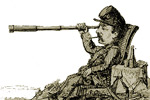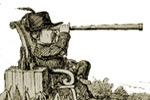
STOP #10
WASHINGTON MONUMENT SIGNAL STATION |
This station was used extensively during the Gettysburg campaign. The
monument was not as tall as it is now but the additional height of the present
structure does not add significantly to the field of view. As you will see from
the reports, trees were cut down in order to get a better view of and from the
monument. On the way back to the car, stop at the visitors center and view the
painting of the monument in use as a signal station.
Take your compass and sight the signal stations from left to right as
follows:
- Middletown - 145 degrees,
- Turner's Gap - 150 degrees,
- Crampton's Gap - 190 degrees,
- Elk Mountain - 225 degrees,
- Hill behind Boonsboro - 295 degrees,
- Approximate location of Buford's tactical signal station at Beaver creek crossing - 322 degrees.
Report of Capt. Lemuel B. Norton, Chief Signal Officer, Army of the Potomac:
On July 10, the general commanding and his staff removed to a
bivouac near Beaver Creek crossing, west of Boonsborough. In the evening,
communication was opened from general headquarters, through Washington
Monument station, with headquarters of the Second and Twelfth Corps, near
Bakersville, Third and Fifth Corps near Antietam Bridge, and the First and
Sixth corps near Beaver Creek crossing on the Hagerstown pike. On this day the
officer who accompanied General Neill on his expedition from a point selected
by him on Franklin's Cliff, South Mountain Range, near Leiterburg, discovered
the numbers and position of the enemy in and around Hagerstown, and sent the
information to General Neill, and by orderly to General Meade ...
On July 13, all signal communications previously established was still kept
up. Two officers were sent to make a telescopic reconnaissance from Elk
Mountain.
[O.R., XXVII, Part I, pp. 203-204.]
Report of Capt. Nahum Daniels, Signal Officer,
Washington Reserve Signal Party
Captain:
I have the honor to submit the following report:
Agreeably to orders received at Frederick, Md., July 7, at 6 p.m. I started
with Captain Denicke, Lieutenants Denicke, Galbraith, Briggs, and Swain to
open communications by signals from the advance of our army, then near
Boonsborough, to Frederick. I left Lieutenant Galbraith at South Mountain
Pass, with instructions to open an intermediate station at that point between
Frederick and Washington Monument. On the morning of the 8th instant, I
ordered Captain Denicke and Lieutenant Denicke to open a station on Washington
Monument; also procured a detail of men to cut away the timber which
obstructed the view near the monument. At 8 a.m. I ordered Lieutenant Swain to
open a station at Boonsborough, then our extreme advance. Lieutenant Briggs
also proceeded to open a station on the Blue [Elk] Ridge, about 4 miles from
Boonsborough. At 10 a.m. our forces commenced skirmishing with the enemy. I
immediately proceeded to the front, and opened communication with the
Washington Monument, about 1 mile from Boonsborough, on the Hagerstown pike. I
directed Lieutenant Swain to take charge of the station at this point. At 11
a.m. I sent the following message to Captain Nicodemus:
Our advance is engaged with the enemy. Captain Denicke reported no
communication yet with Frederick. It being now quite clear, I ordered
Captain Dencke to report by signal to me the movements of the enemy, which I
reported to the commanding officer in front. Our forces were now engaged a
distance of 3 miles in front. Lieutenant Swain remained at his post receiving
messages subject to a severe fire. I cannot too highly mention his bearing
while under fire. At 1 p.m. the engagement became quite warm, Captain Denicke
reporting constantly to me the every movement of the enemy, which was
immediately reported to General Buford, while he by such reports was enabled
to be fully prepared to meet every movement of the enemy, knowing in advance
what their force was, and the kind of force. At 3 p.m., finding that
communication was not open to Frederick, I ordered Lieutenant Denicke to
assist Lieutenant Galbraith in opening through to that place.
[O.R., XXVII, Part I, pp. 208-2091]
This station was
significant in that it served as a key station of observation and that
information gathered by Capt. Denicke was quickly relayed through Capt. Daniels
to Brig. Gen. Buford in the Antietam Valley. Below is a representative sample of
the message traffic sent from Denicke and passed to Buford by Daniels as well as
some general traffic.
General Buford:
The enemy are advancing in front and on our right. A large cavalry
force in front.
Daniels, Captain
General Buford:
Enemy are advancing; skirmishing on our right.
Daniels, Captain
General Buford:
Enemy-have just placed a battery on left of road,
behind-a large barn.
Daniels, Captain
Captain Nicodemus:
Enemy's cavalry pickets are 1 mile in advance.
Daniels, Captain
General Commanding:
The enemy are advancing infantry and cavalry across
the Antietam about 1 mile to our left.
Daniels, Captain
[O.R., XXVII, PART I, pp. 201-202.]
Report of Lieut. Julius M. Swain, Acting Signal Officer,
Washington Reserve Signal Party:
Captain:
I beg leave to submit the following report, which I
regret contains but an imperfect record of the messages sent while with the
signal party recently under your command in Maryland.
I had the misfortune to lose my memorandum book containing a copy of the
messages sent to General Buford from station near-Boonsborough during the
engagement on the afternoon of the 8th instant, as well as some others of
later date.
In accordance, with your orders, I left Frederick on the evening of the 7th
instant, and proceeded to South Mountain Gap, in company with Captain Denicke,
at which point we were ordered to-report to Captain Daniels, July 8. We
arrived at 3 a.m., and as it was raining very hard and Captain Daniels could
not be found, we lay by till daylight.
Captain Daniels arrived at the Mountain House at 8 o'clock, and as soon as
the weather would permit, about 9 a.m., I was ordered to Boonsborough, where I
arrived a 10 o'clock, and reported to General Kilpatrick, after which I opened
station on hill in rear of town, which commanded a good view of our front.
At 12 n. Captain Daniels opened station near the Hagerstown pike, about 1
mile beyond Boonsborough, and ordered me to join him which I did at once.
I remained there during the day in communication with Captain Denicke, on
Washington Monument, whose station overlooked the enemy, and sent frequent
messages from him to General Buford, then in command.
At 3 p.m. sent the following:
Captain Denicke:
Lieutenant Denicke will
open communication between you and Frederick.
Daniels, Captain
July 9. - Enemy retreated last evening about 2 miles toward Funkstown, and
Captain Daniels went to front this morning, leaving me on the station opened
yesterday.
On your arrival, about noon, you ordered me to send frequent dispatches to
Colonel Myer at Washington, apprising him of all movements of
interest.
Sent following:
Boonsborough July 9 - 7.30 p.m.
Heavy skirmishing has just opened about
3 miles from here, on Hagerstown road.
Nicodemus, Captain.
July 10, Removed station to hill near Boonsborough, and opened
communication with Lieutenant Tuckerman on left of our line, with Captain
Denicke on Monument, and Captain Stone on Sharpsburg pike, near General
French's headquarters ...
[O.R., XXVII, Part I, pp. 217-218]
Now you should walk back to your car and drive to STOP 11.
Return to ALT 40 and drive 1.6 miles towards BOONSBORO turning LEFT on
ROUTE 67. Drive for 7.1 miles and turn LEFT on GAPLAND ROAD. Drive one mile to
GATHLAND STATE PARK. On the way up the mountain, notice the high ground to the
left. Park in the parking lot by the CORRESPONDENT'S MEMORIAL ARCH.
|




